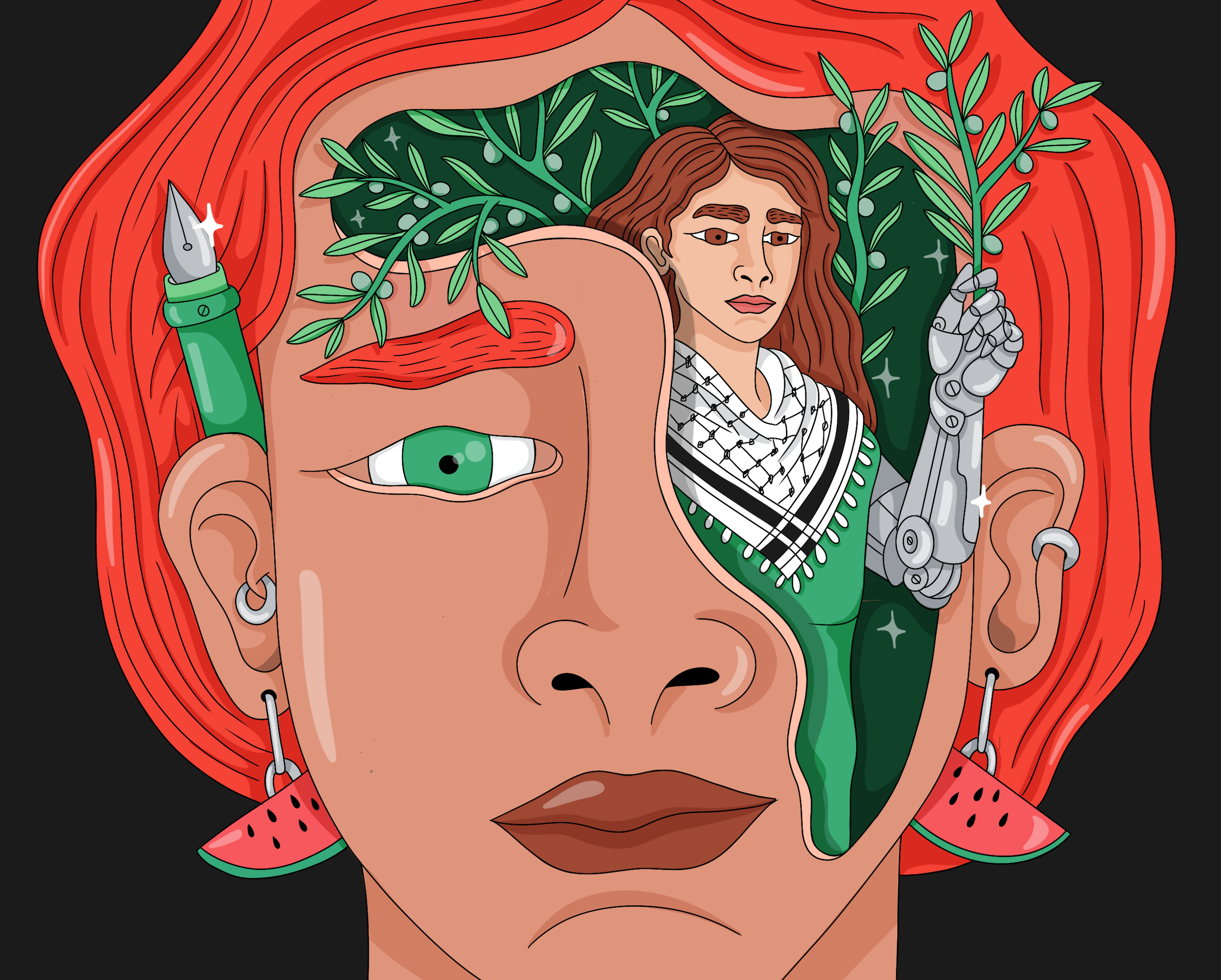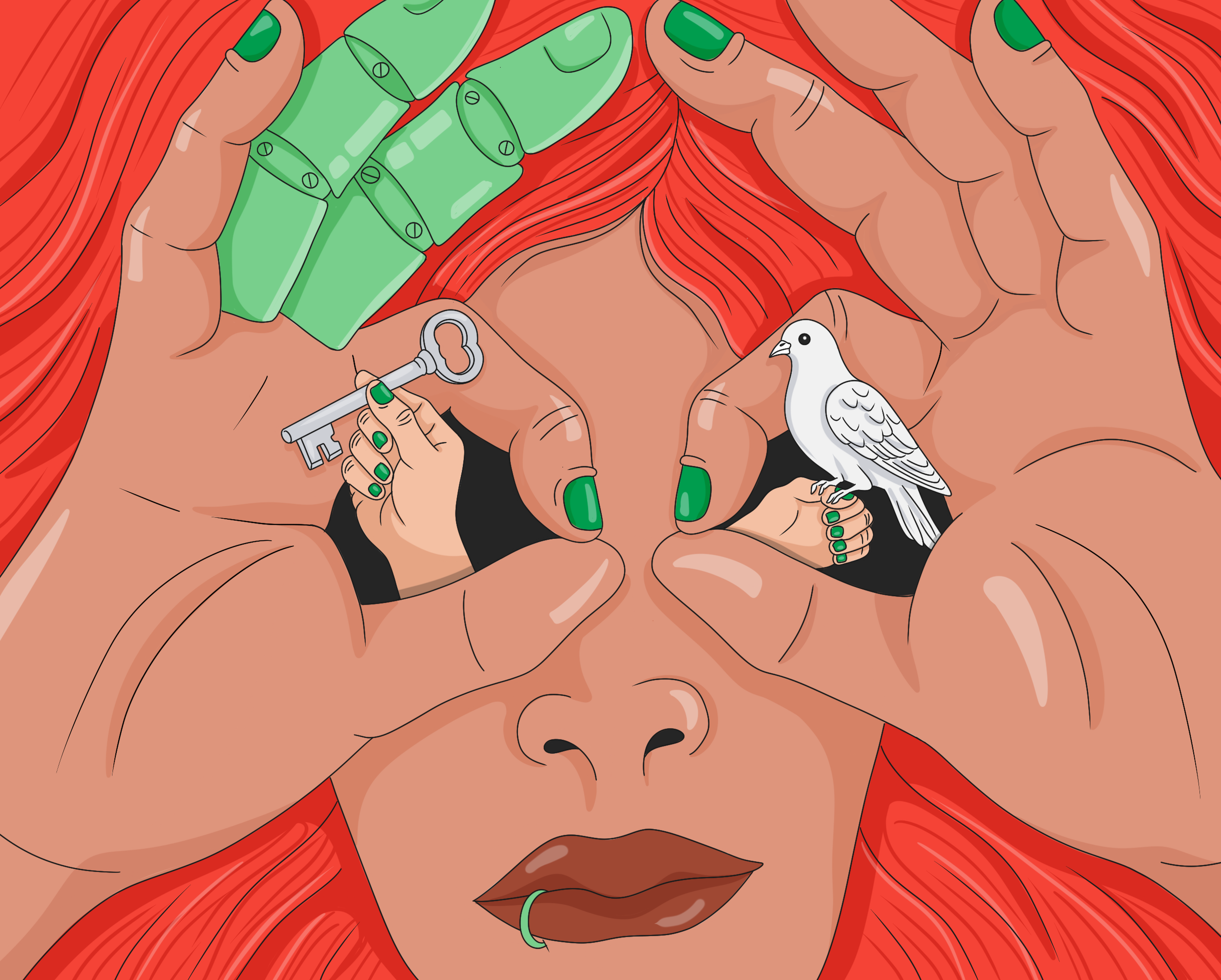Imagining Palestinian Futures
illustration by Lynne Zakhour
Like much of the rest of the world, we (as a project and individuals) are devastated and outraged by what is and has been happening in Palestine (the ongoing genocide in Gaza, but also, importantly, escalating violence in the West Bank). The deliberate bombing of hospitals, schools, refugee camps; the targeting of journalists, health workers, and people seeking food; and purposeful withholding of life essential requirements – food, water, electricity, shelter and access to healthcare - are atrocities (amounting not only to human rights violations and collective punishment, but a genocide) that we cannot ignore. As I write this, we are witnessing the deliberate starving of the entire population of Gaza. And yet, governments like the UK insist on largely excusing and/or denying these acts, while at the same time, criminalizing protest (labelling it terrorist) that speaks out against these acts. We are appalled at their moral and practical failure, continued complicity and refusal to act.
For our project, and for many disability-focused groups, it is important to be reminded of how the violence in Palestine done in the name of settler-colonialism - a long-standing system of oppression – is inextricably tied to disability justice.
‘Disability justice cannot exist under settler colonialism, military occupation, imprisonment, and apartheid. We write this in support of the Palestinian struggle for freedom, dignity, and self-determination’
Disability Divest – a collective of disabled individuals calling for a Free Palestine – draws attention to how disability has figured centrally in the Israeli campaign in Gaza for the past 22 months, pointing out how Palestine now has the largest cohort of child amputees. Disability activist and author Leah Lakshmi Piepzna-Samarasinha has decried how ‘everyone in Palestine is disabled right now.’ Of course, the focus on Palestine and its ongoing experience of disablement is not limited to the past 22 months. Jasbir Puar’s The Right to Maim describes not only the way in which actions causing disability have been central to how Israel has treated Palestinians since 1948, but how debility – bodily injury and social exclusion brought on by economic and political factors – is the means through which Palestinian bodies come under the biopolitical control of imperial and racial capitalism. Puar reflects elsewhere on the calls of the Abolition and Disability Justice Coalition and how, ‘by highlighting the carceral infrastructures that demobilize, rather than reiterating the conventional focus on accessibility, universal design, identity, and rights, the conviviality of abolition and decolonization entails, in this case, the abolition of the carceral structures of occupation and the decolonization of Palestine.’ (Puar, pp.129)
As we have witnessed the thousands of images and videos of ongoing destruction of Gaza on our smartphones and computer screens, one wonders how on earth this violence continues, how the very institutions and governments that are meant to uphold international law have not responded to bring this to an end. I also note, of course, the regular and growing international protests calling for a ceasefire. Yet as Palestinian activist Aseel Baidoun asks:
Why would I keep sharing and writing when no one is listening. They’re all complicit in this. And I just feel we’re wasting our time. It’s not like the issue is lacking narrative or lacking reality. It’s all there, live. It’s broadcasted live, but no one actually cares.
In Christina Sharpe’s powerful book, In the Wake, she considers what we can understand by the repetition of violent imagery and its inability to bring about change, in an albeit different context. She explains
We have been reminded by Hartman and many others that the repetition of the visual, discursive, state, and other quotidian and extraordinary cruel and unusual violences enacted on Black people does not lead to a cessation of violence, nor does it, across or within communities, lead primarily to sympathy or something like empathy. Such repetitions often work to solidify and make continuous the colonial project of violence [emphasis added]. With that knowledge in mind, what kinds of ethical viewing and reading practices must we employ, now, in the face of these onslaughts?
Christina Sharpe, In the Wake: On Blackness and Being, pp. 116–117.
Like Saidiya Hartman’s work that ‘re-interprets’ the lives of photographed young, Black women in the early 20th Century U.S., Sharpe’s words orient us towards the possibilities of what might be if we reconsider our imagining practices and how we read these images. Sharpe encourages us to think about the work of viewing, reading, redacting and remaking visual texts and images as ways of seeing otherwise, beyond the repetitions of (settler) colonial violence.
At this moment, it is important that we look to the work of Palestinian artists, who have sought to do just this, to see otherwise/beyond the repetitions of settler colonial violence and to use the power of art to do so. In her article, Hoda El-Shakry (2021) looks to Palestinian artists who draw on ‘speculative modes of world-building that bridge past and future temporalities in order to render legible the unviability of the present.’ She references Palestine+100: Stories from a Century After the Nakba, a collection of ‘science fiction’ stories that considers what Palestine would look like in 2048, 100 years after the 1948 Nakba. She also looks at the work of Palestinian artist Larissa Sansour. Sansour works in film, photography, sculpture, installation and opera, and uses science and speculative fiction to both remember Palestinian pasts and imagine Palestinian futures. For example, Nation Estate (2012) – my first introduction to Sansour’s work many years ago – is a film which sees future Palestinians living in a contemporary high-rise, each with their own floor, ‘built just outside the city of Jerusalem and surrounded by a concrete enclosure wall’ (El-Shakry, pp. 682). In the Future they Ate From the Finest Porcelain (2016), which I viewed at the Barbican in London, we witness a ‘narrative resistance group’ travel back in time to bury elaborate porcelain of a fictional people, to support future claims to a vanishing land. These science fictional films are powerful, refusing to let a witness read this stake on land, history and futures through the lens of settler colonialism’s desire to eradicate peoples, pasts and futures. Sansour’s own reflections on her work speak to how speculative fiction ‘enables imaginative critical interventions otherwise unavailable within the violent realities of the ongoing occupation’ (El-Shakry, pp. 681).
I look also to the work of Scottish-based Palestinian artist Farah Saleh, and her work Balfour Reparations (2024–2044): Imagining Counter Palestinian Futures by Confronting Histories of Erasure. Here Saleh draws on critical fabulation, archival materials and dance to confront the United Kingdom’s colonial legacy in Palestine, where she – and the audience – are the Reparations Committee reflecting on a fictional UK government apology issued two decades earlier. For those in or near to Scotland in August 2025, a live performance of Saleh’s Balfour Reparations can be seen at this year’s Edinburgh Fringe Festival from 13–25 August. (You can also see a programme of Palestinian art and performance at Welcome to the Fringe, Palestine from 12–15 August 2025!)
illustration by Lynne Zakhour
Doing Disability Futures orients itself towards futures that are possible in spaces shaped by European colonialism and/or those subjected to eugenics killings. It is this orientation to the future that turns back to the past that, we argue, opens up readings to other possibilities, to not only seeing the teleology of settler colonialism. This does not ignore the past – its genocides and broader violence – as it is firmly looking back to see what has been ignored, silenced, eradicated, but maybe re-emerges, perhaps transformed, in other possible futures.
These (and other) Palestinian artists employ what Sharpe calls for: ethical readings and ways of seeing beyond the repetitions of ongoing settler-colonial violence, or seeing otherwise. So, while we must continue to speak out in opposition to the ongoing genocide, we also must also look to and support the work of those doing the work to imagine a free Palestine, a Palestine firmly in the future. Doing Disability Futures reaffirms that there is no disability justice without a free Palestine. We look to the present, speaking out where possible, to bear witness to Palestine in the present so that it may thrive in its many futures.

